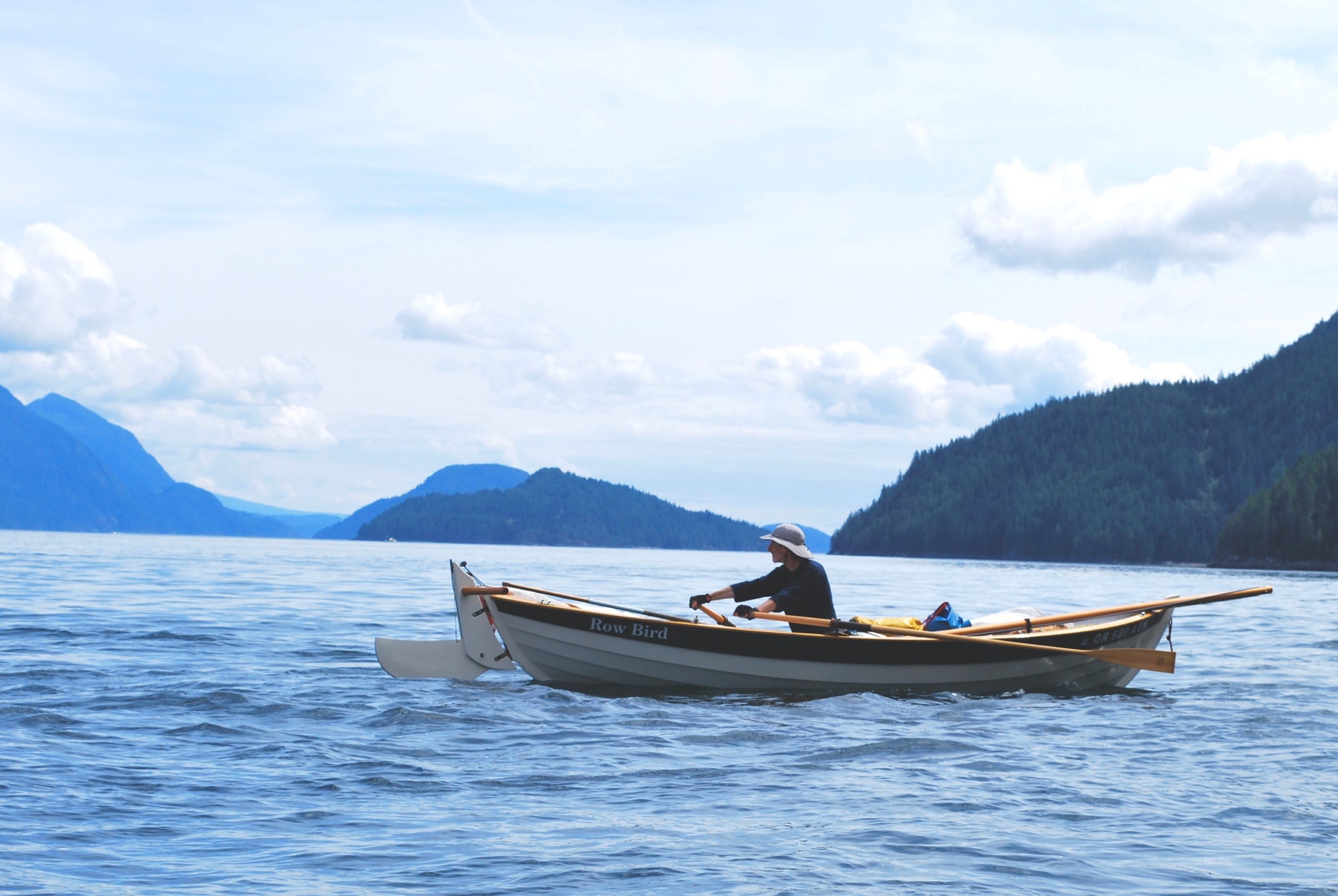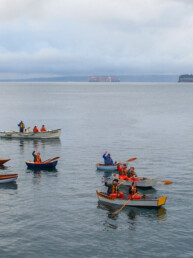In our latest Throwback Thursday, heading south from the Broughtons on a small boat, the big rapids of the Inside Passage are calling.
If you haven’t already read the first in Bruce’s series on his Inside Passage small boat adventure, check it out here.
Every cruising guide has advice about how to run a rapid, but none speak to the motorless sailor. So as I cruised south through the Inside Passage last summer, I knew I’d have to follow the advice of a friend when I encountered swift moving water along my route in the back channels that hug mainland British Columbia. “Nose in as early as you can,” he’d told me. “Give way to every boat, and just before the tide turns in your favor, row hard.”
I approached my first significant tidal gate, Whirlpool Rapids, on a damp morning with billowing fog. I’d spent the previous night hiding from shifting winds in the only safe anchorage I could reach—a tiny cove next to a noisy fish farm. I slept fitfully, but it wasn’t the loud hum of generators that troubled my rest, it was the tale another boater had told me a few days earlier about a 100-foot ship that had been sucked into another whirlpool and foundered.

I checked my watch several times, confirming that the predicted slack was imminent. Seeing nothing of concern, I rowed into the narrows at full speed, wondering if I was missing something. Aside from seaweed thrashing in the depths, there were no whirlpools, overfalls, or any other intimidating conditions. After 10 minutes, I peeked at the chart and discovered that I was already well downstream. I was relieved, but a bit annoyed that I’d worked myself up over nothing.
A few days later I arrived in Cordero Channel at mid-morning, hoping to navigate Greene Point Rapids. With the ebb churning against me, I crept along the shore, hugging the kelp, occasionally catching an eddy that pulled me forward, and almost immediately encountering another that sucked me back. By an hour before slack, I had swirled in a big circle enough times to realize that navigating Greene Point was a no-go for now. I tied a line to a clump of kelp and relaxed.
Bonaparte’s gulls cavorted on a log that bobbed nearby. Small whirlpools formed, sucking down driftwood that disappeared into the unknown. Looking in the distance, I was confused by what appeared to be white chunks of Styrofoam drifting downstream. As they got closer, I trained my binoculars on them to discover basketball-sized, frothy spume churned up by an unknown danger. I decided it was a sure sign that I was wise to wait. And after all, I had nowhere in particular to be other than right there.

When the current lessened, I rowed out and inched forward, working the eddies again, traveling in the shallowest water I dared. Soon I was passing giant charted rocks and a settlement of vacation homes as the current began to move with me. I couldn’t suppress a grin as I zipped down the channel, devoid of whitewater, and into the thick of the rapids indicated on the chart. Elated as a following breeze appeared, I hoisted sail for a downwind run through the last section of bumpy, but manageable current.
As I tied up at a dock in Shoal Bay, I reflected that I was about halfway through the string of six rapids on my chosen route. All had gone well, yet I couldn’t help feeling that, despite my careful timing and preparation, my safe passages were attributable more to luck than anything else.
The final challenge loomed in my mind as I headed toward the triple rapids of Dent, Gillard, and Yaculta. A few nights earlier, I’d had dinner with kayakers turned motor cruisers. Sitting in their cabin, we pored over the charts, making notations about stopping points, cautions, and the most likely areas of smooth water.

The plan we made worked so well that, before the tide turned, I was able to slip into the backwaters between Dent Island and the rapids themselves. Even here, the water boiled, pulling Row Bird around like a moon in thrall to the gravity of a planet. I was alert and fully aware of my position in a safe harbor as I watched streams of bubbling, frothy water pour over rocks in the rapids just a few hundred feet away. My heart pounded, thinking of the raw power so close by.
When the first powerboats started pushing into the rapids, I lined up on the edge of the channel. They gave me a wide berth, and one even lingered a bit, as if gauging whether or not I would need a rescue. I was grateful for the consideration, but my gut told me I was on my own. Rowing forward, I stuck to the sides, avoiding wakes and glancing over my shoulder in search of current lines.
On a waterproof notebook that now rested by my feet, I’d scrawled the time of slack and max ebb at each of the three rapids. I must have glanced down at those notations a dozen times during the next three miles before I allowed myself to exult: my intense rowing, combined with the pull of the current, meant that I was going to run the two remaining rapids in one tide cycle.
When I pulled into the calmer water at the south end of Yaculta Rapids, I felt like I’d unexpectedly won the Tour de France, though not a single spectator was here to cheer me on. Drenched in sweat, I waved to a passing fishing boat to snap my picture.

Looking back on those images today, I see excitement in my expression, as well as relief. Back when I was planning this voyage, the series of rapids on my route had played starring roles in imagined disaster scenarios. Yet despite being separated from the intensity of those waters by just a few inches of freeboard, I’d managed to safely navigate them all. Maybe it was chance, or maybe it was skill, preparation and planning, after all. Either way, I felt I’d passed a milestone in my life as a sailor.
Bruce Bateau
Bruce Bateau sails and rows traditional boats with a modern twist in Portland, Ore. His stories and adventures can be found at www.terrapintales.wordpress.com






